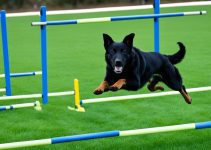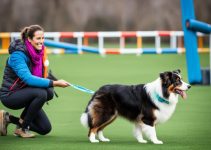Boxer training is an important step in ensuring a well-behaved and happy pet. Whether you have a playful Boxer puppy or an adult dog, implementing effective training techniques will help foster obedience and strengthen the bond between you and your furry friend. In this section, I will provide you with valuable tips and techniques for Boxer training, including obedience training, agility training, and the best exercises to keep your pet in top shape.
Training a Boxer requires consistency, patience, and positive reinforcement. By using praise, treats, and rewards, you can motivate your Boxer to follow commands and exhibit the desired behaviors. From basic commands such as “sit” and “stay” to more advanced tricks, the right training approach will help your Boxer become a well-mannered and obedient companion.
Boxers are intelligent and energetic dogs, making them excellent candidates for agility training. Engaging in agility exercises not only provides mental stimulation for your Boxer but also helps them develop coordination, balance, and focus. Incorporating agility training into your Boxer’s routine will enhance their overall physical fitness and provide them with an outlet for their abundant energy.
To ensure a balanced training program, it’s essential to incorporate a variety of exercises into your Boxer’s routine. Regular walks, jogs, and interactive play sessions are ideal for keeping your pet physically active and mentally stimulated. Choosing the right exercises will not only help prevent boredom but also support your Boxer’s overall health and well-being.
Remember, training a Boxer is a journey that requires dedication and commitment. With proper training, you can shape your Boxer into a well-behaved, obedient, and happy pet.
Boxer Training You Should Know
- Consistency, patience, and positive reinforcement are key components of Boxer training.
- Agility training can provide mental stimulation and enhance your Boxer’s physical fitness.
- Incorporate a variety of exercises to keep your Boxer active, engaged, and in top shape.
- Choose the right training approach and techniques to foster obedience and a strong bond with your Boxer.
- Training a Boxer requires dedication and commitment, but the rewards are well worth it.
The Importance of Premium Diet Choices for Your Boxer’s Health
The diet you choose for your Boxer plays a crucial role in their overall health and well-being. As a responsible pet owner, it’s essential to prioritize their nutrition. Providing your Boxer with a high-quality diet is key to keeping them healthy and happy.
When it comes to boxer diet, it’s important to avoid low-quality fillers and harmful preservatives. Opt for premium dog food brands that use real, nutritious ingredients. Look for formulas that are specifically designed for boxers, taking into account their unique dietary needs.
Additionally, incorporating natural boxer snacks into their diet can offer numerous benefits. Fresh fruits and vegetables serve as excellent sources of essential vitamins, minerals, and antioxidants. These natural snacks contribute to a strong immune system, promote healthy digestion, and support overall wellness.
Alongside their diet, boxer hydration is equally important. Proper hydration is vital for your Boxer’s overall well-being. Make sure your furry friend has access to fresh, filtered or spring water at all times. Ensuring they drink an adequate quantity of water helps maintain optimal hydration levels and supports proper bodily functions.

By prioritizing premium diet choices and providing natural boxer snacks, you are giving your Boxer the nutrients they need to thrive. Combined with proper hydration, you can ensure their health and well-being are always at their best.
Creating an Exercise Regimen Suitable for Your Boxer’s Needs
Boxers are known for their boundless energy and active nature. To keep your Boxer happy and maintain their physical well-being, it’s important to establish a suitable exercise regimen. Here are some ideas to help you meet your Boxer’s exercise needs:
- Daily Walks: Take your Boxer for brisk daily walks to provide them with the physical activity they need. A 30-minute walk is usually sufficient, but you can adjust the duration depending on your dog’s energy level and overall health.
- Interactive Play: Engage your Boxer in interactive play sessions. This can include games like fetch, tug-of-war, or hide-and-seek. Interactive play not only keeps your Boxer physically active but also stimulates their mind.
- Canine Sports: Consider participating in canine sports activities with your Boxer, such as agility training or obedience trials. These activities provide mental and physical stimulation, helping your Boxer stay fit while building a deeper bond with you.
- Free Play: Allow your Boxer to have time for free play in a secure and supervised environment. This gives them the opportunity to explore their surroundings, interact with other dogs, and burn off excess energy.
Remember to tailor the exercise regimen to your Boxer’s age, health condition, and individual preferences. Regular physical activity, combined with a balanced diet, will contribute to a healthy and happy Boxer.
Continue reading to learn about how to protect your curious Boxer puppy at home.
Protecting Your Curious Boxer Puppy at Home
Boxer puppies are curious and full of energy, always ready to explore their surroundings. However, their inquisitiveness can sometimes lead them into risky situations. That’s why it’s crucial to take the necessary steps to dog-proof your home and ensure the safety of your furry friend.
One important aspect of boxer puppy safety is providing them with safe items for chewing and play. By offering appropriate chew toys, you can redirect their chewing habits and protect your valuable possessions from their sharp little teeth. It’s essential to choose chew toys specifically designed for boxers, as they are durable and safe for their strong jaws.
When selecting chew toys for boxers, opt for those made from non-toxic materials that won’t break or splinter easily. Look for toys that are easy to clean and inspect regularly for signs of wear and tear. Remember, providing safe chew toys not only keeps your boxer entertained but also promotes dental health by reducing tartar build-up.
To ensure a puppy-proof home environment, it’s important to identify and eliminate any potential hazards. Secure loose electrical cords, keep toxic plants out of reach, and use baby gates to restrict access to hazardous areas. Store cleaning products, medications, and chemicals in locked cabinets to prevent accidental ingestion.
Furthermore, it’s crucial to supervise your boxer puppy at all times, especially if they’re in a new environment. This allows you to quickly address any potential dangers and redirect their attention to safe activities. By providing a safe and supervised environment, you’ll prevent accidents and protect your curious boxer puppy.
Key Tips for Puppy-Proofing Your Home:
- Secure loose electrical cords and keep them out of reach.
- Remove toxic plants or place them in inaccessible areas.
- Use baby gates to restrict access to hazardous rooms or areas.
- Store cleaning products, medications, and chemicals in locked cabinets.
- Supervise your boxer puppy at all times to prevent potential accidents.

By following these guidelines for boxer puppy safety and puppy-proofing your home, you can ensure a secure environment for your furry companion. Remember, prevention is key when it comes to keeping your curious boxer puppy out of harm’s way.
Feeding Techniques to Prevent Health Issues
Proper feeding techniques play a crucial role in preventing health issues in Boxers. By following these guidelines, you can ensure your furry friend stays healthy and happy.
1. Slow-Feeder Bowl for Boxers
A slow-feeder bowl can be a valuable tool in preventing bloating and aiding digestion in Boxers. These specially designed bowls have unique ridges or obstacles that slow down your pup’s eating pace, reducing the risk of gulping air and stomach torsion.
2. Stainless Steel Dishes for Boxers
When it comes to feeding your Boxer, opt for stainless steel dishes. Not only are they durable and easy to clean, but they also minimize the risk of allergies that can be caused by plastic or ceramic bowls. Stainless steel is non-porous, reducing the accumulation of bacteria and keeping your Boxer healthy.
3. Portion Pacers for Boxers
Portion pacers are handy tools for managing your Boxer’s eating speed. These devices are specifically designed to slow down the pace at which your dog consumes their food. By promoting slower eating, portion pacers can help prevent choking hazards, bloating, and other digestive issues.
4. Crate Training for Potty Training
Crate training is not only beneficial for potty training but also for creating a safe and secure space for your Boxer. Dogs have an innate desire to have their own den, and a crate provides them with a cozy and den-like environment. By incorporating crate training into your potty training routine, you can effectively teach your Boxer proper bathroom habits.
Implementing these feeding techniques can help ensure your Boxer remains healthy and free from common health issues. Remember to consult with your veterinarian for personalized advice on your Boxer’s specific dietary needs.
Conclusion
Proper Boxer training is crucial for a well-behaved and happy pet. As a proud Boxer owner, I understand the importance of consistency, patience, and positive reinforcement in training. By using these effective training tips for boxers, you can establish a strong bond with your furry friend and ensure their obedience and happiness.
However, Boxer training is just one piece of the puzzle. To maintain a healthy lifestyle for your Boxer, it is essential to provide them with a balanced diet. By following proper boxer feeding techniques, such as using slow-feeder bowls and stainless steel dishes, you can prevent health issues and promote their well-being.
In addition to Boxer training and diet, meeting the exercise needs of your Boxer is vital. Regular physical activity, such as daily walks and interactive play, not only keeps them fit but also stimulates their mind. You can also engage them in canine sports to provide them with mental and physical challenges.
Lastly, boxer puppy safety is paramount. By dog-proofing your home and providing safe chew toys, you can protect your curious Boxer puppy from potential dangers and redirect their natural chewing behaviors. Creating a safe environment allows your puppy to explore and grow without unnecessary risks.
Remember, being a responsible Boxer owner involves incorporating proper training techniques, providing a nutritious diet, fulfilling exercise needs, and ensuring their safety. By following these guidelines and techniques, you can raise a happy, healthy, and obedient Boxer who will bring you joy for years to come.
FAQ
What are some training tips for boxers?
Consistency, patience, and positive reinforcement are key components of boxer training. Providing a balanced diet, regular exercise, and a safe home environment are also essential.
How can I train my boxer puppy?
Training a boxer puppy requires consistency, positive reinforcement, and patience. Crate training, potty training, and socialization are important aspects to focus on.
What are some effective boxer training techniques?
Boxer training techniques include using positive reinforcement, reward-based training, and consistent commands. Obedience training, agility training, and leash training are also beneficial.
How do I dog-proof my home for a curious boxer puppy?
To dog-proof your home for a boxer puppy, secure electrical cords and hazardous items, use baby gates to limit access to certain areas, and provide safe chewing toys and interactive toys to redirect their curiosity.
What feeding techniques can prevent health issues in boxers?
Feeding techniques to prevent health issues in boxers include using a slow-feeder bowl to prevent bloating, choosing stainless steel dishes for hygiene, and using portion pacers to regulate eating speed.






